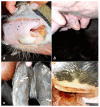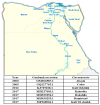The Current Epizootiological Situation of Three Major Viral Infections Affecting Cattle in Egypt
- PMID: 39459870
- PMCID: PMC11512213
- DOI: 10.3390/v16101536
The Current Epizootiological Situation of Three Major Viral Infections Affecting Cattle in Egypt
Abstract
One of the major factors hindering efficient livestock production is the presence of high-impact infectious animal diseases, such as foot and mouth disease (FMD), lumpy skin disease (LSD), and bovine ephemeral fever (BEF), which are notable viral infections affecting cattle in Egypt, leading to significant economic losses. FMD is caused by the foot and mouth disease virus (FMDV) of the genus Aphthovirus in the Picornaviridae family. LSD is caused by lumpy skin disease virus (LSDV) of Capripox genus within the Poxviridae family, subfamily Chordopoxvirinae. BEF is caused by bovine ephemeral fever virus (BEFV) of genus Ephemerovirus in the Rhabdoviridae family. FMD is a highly contagious viral infection of domestic and wild cloven-hooved animals and can spread through the wind. On the other hand, LSD and BEF are arthropod-borne viral diseases that mainly affect domestic cattle and water buffalo. Despite government vaccination efforts, these three viral diseases have become widespread in Egypt, with several reported epidemics. Egypt's importation of large numbers of animals from different countries, combined with unregulated animal movements through trading and borders between African countries and Egypt, facilitates the introduction of new FMDV serotypes and lineages not covered by the current vaccination plans. To establish an effective control program, countries need to assess the real epizootic situation of various infectious animal diseases to develop an efficient early warning system. This review provides information about FMD, LSD, and BEF, including their economic impacts, causative viruses, global burden, the situation in Egypt, and the challenges in controlling these diseases.
Keywords: bovine ephemeral fever; cattle; foot and mouth disease; lumpy skin disease.
Conflict of interest statement
The authors declare no conflict of interest.
Figures









References
-
- Ghonaim A.H., Hopo M.G., Ghonaim N.H., Jiang Y., He Q., Li W. The Epidemiology of Circulating Rotavirus Associated with Diarrhea in Egyptian Kids and Calves: A Review. Zoonoses. 2023;3:985. doi: 10.15212/ZOONOSES-2023-0004. - DOI
-
- Teifke J.P., Breithaupt A., Haas B. Foot-and-mouth disease and its differential diagnoses. Tierarztl. Praxis Ausg. G Grosstiere/Nutztiere. 2012;40:225–237. quiz 238. - PubMed
Publication types
MeSH terms
LinkOut - more resources
Full Text Sources

